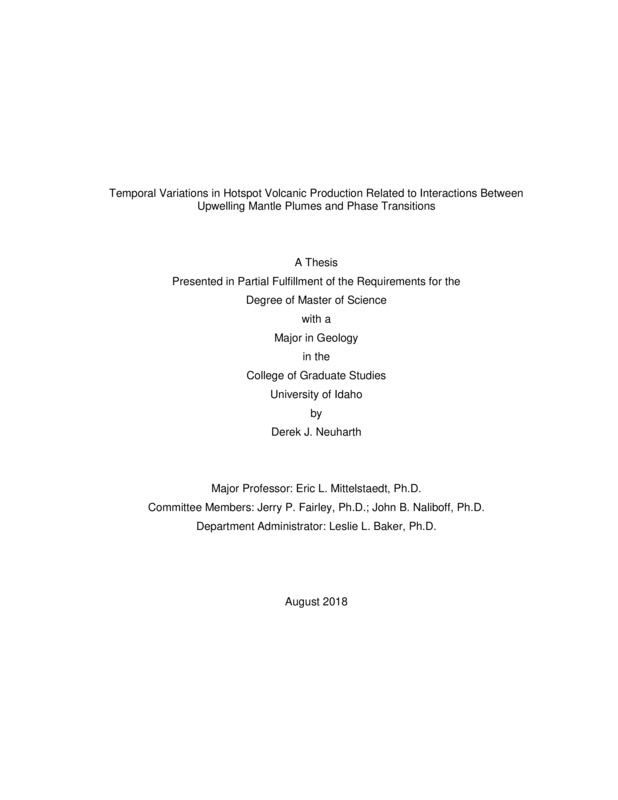Temporal Variations in Hotspot Volcanic Production Related to Interactions Between Upwelling Mantle Plumes and Phase Transitions
Neuharth, Derek John. (2018-08). Temporal Variations in Hotspot Volcanic Production Related to Interactions Between Upwelling Mantle Plumes and Phase Transitions. Theses and Dissertations Collection, University of Idaho Library Digital Collections. https://www.lib.uidaho.edu/digital/etd/items/neuharth_idaho_0089n_11435.html
- Title:
- Temporal Variations in Hotspot Volcanic Production Related to Interactions Between Upwelling Mantle Plumes and Phase Transitions
- Author:
- Neuharth, Derek John
- Date:
- 2018-08
- Keywords:
- mantle plume phase transition pulsing tilt
- Program:
- Geology
- Subject Category:
- Geology; Geophysics
- Abstract:
-
Observations at numerous hotspots around the globe, such as Hawaii and Louisville, find periodic variations in volcanic production with time. For example, the volcanic production rate along the Hawaiian seamount chain varies from 0.05 to 0.25 km3 yr-1 at periods of ~15 Myr, while volcanic production rate along the Louisville seamount chain in the southern Pacific Ocean has consistently declined over the past ~40 Myr. One possible explanation for these variations is long-term interaction of upwelling mantle plumes with mantle phase transitions. While previous studies carefully quantify the initial interaction and subsequent penetration or inhibition of a plume as it encounters the 660 km phase boundary and traverses the transition zone, the long term interaction of plume upwelling and phase boundaries in the mantle is not well constrained. To assess the impact of plume-phase transition interaction on observed variability in hotspot volcanic output, I use the Advanced Solver for Problems in Earth’s ConvecTion (ASPECT) code to numerically simulate upwelling of an isolated plume under the Anelastic Liquid Approximation (ALA). I use a 2D annulus geometry with a 90° opening width and mantle thickness of 2855 km. Plume upwelling is initiated by imposing anomalously warm (∆T 550 K) temperatures across a zone 600 km wide centered at the base of the model. At the 660 km and 410 km depth mantle phase transitions I simulate changes in density, viscosity, and the release of latent heat. Models evolve for up to 400 Myr. To test the effect of differing mantle compositions, I vary the Clapeyron slopes from 0 to 4 MPa and -4 to 0 MPa at the 410 km and 660 km phase transitions, respectively. Similar to other studies, results show an initial flattening of the plume head at the 660 km transition before penetration and subsequent acceleration across the 410 km transition, coinciding with mild flattening of the 660 km, and deepening of the 410 km. At sufficiently low 660 km transition Clapeyron slopes (~-3.2 MPa K-1), secondary plumes form at a mid-mantle thermal boundary layer that forms as inhibited material spreads laterally underneath the transition. The spacing of these secondary plumes (~200-1200 km) is similar to surface observations (e.g., Iceland, East African Rift). By including imposed surface velocities (0-8 cm yr-1), volume flux variations are seen from plume conduit instabilities that form when the conduit tilts ~88º from vertical. These variations have a periodicity between ~4.1-37.9 Myr, which is similar to those seen at Hawaii and Iceland.
- Description:
- masters, M.S., Geology -- University of Idaho - College of Graduate Studies, 2018-08
- Major Professor:
- Mittelstaedt, Eric L.
- Committee:
- Fairley, Jerry P.; Naliboff, John B.
- Defense Date:
- 2018-08
- Identifier:
- Neuharth_idaho_0089N_11435
- Type:
- Text
- Format Original:
- Format:
- application/pdf
- Rights:
- In Copyright - Educational Use Permitted. For more information, please contact University of Idaho Library Special Collections and Archives Department at libspec@uidaho.edu.
- Standardized Rights:
- http://rightsstatements.org/vocab/InC-EDU/1.0/

